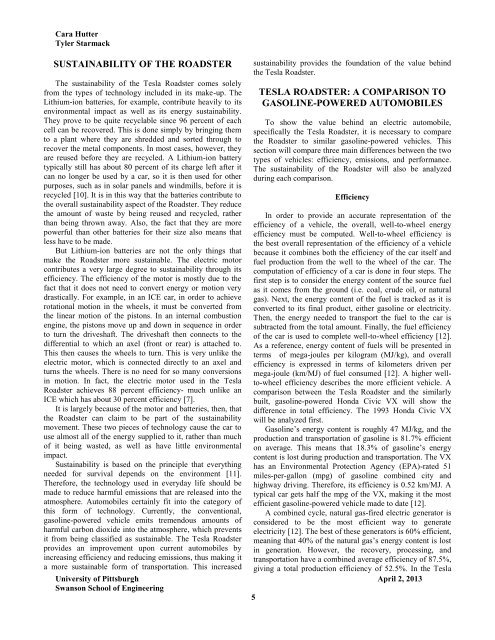TESLA ROADSTER: THE NEW STANDARD OF ELECTRIC AUTOMOBILES
Create successful ePaper yourself
Turn your PDF publications into a flip-book with our unique Google optimized e-Paper software.
Cara Hutter<br />
Tyler Starmack<br />
SUSTAINABILITY <strong>OF</strong> <strong>THE</strong> <strong>ROADSTER</strong><br />
The sustainability of the Tesla Roadster comes solely<br />
from the types of technology included in its make-up. The<br />
Lithium-ion batteries, for example, contribute heavily to its<br />
environmental impact as well as its energy sustainability.<br />
They prove to be quite recyclable since 96 percent of each<br />
cell can be recovered. This is done simply by bringing them<br />
to a plant where they are shredded and sorted through to<br />
recover the metal components. In most cases, however, they<br />
are reused before they are recycled. A Lithium-ion battery<br />
typically still has about 80 percent of its charge left after it<br />
can no longer be used by a car, so it is then used for other<br />
purposes, such as in solar panels and windmills, before it is<br />
recycled [10]. It is in this way that the batteries contribute to<br />
the overall sustainability aspect of the Roadster. They reduce<br />
the amount of waste by being reused and recycled, rather<br />
than being thrown away. Also, the fact that they are more<br />
powerful than other batteries for their size also means that<br />
less have to be made.<br />
But Lithium-ion batteries are not the only things that<br />
make the Roadster more sustainable. The electric motor<br />
contributes a very large degree to sustainability through its<br />
efficiency. The efficiency of the motor is mostly due to the<br />
fact that it does not need to convert energy or motion very<br />
drastically. For example, in an ICE car, in order to achieve<br />
rotational motion in the wheels, it must be converted from<br />
the linear motion of the pistons. In an internal combustion<br />
engine, the pistons move up and down in sequence in order<br />
to turn the driveshaft. The driveshaft then connects to the<br />
differential to which an axel (front or rear) is attached to.<br />
This then causes the wheels to turn. This is very unlike the<br />
electric motor, which is connected directly to an axel and<br />
turns the wheels. There is no need for so many conversions<br />
in motion. In fact, the electric motor used in the Tesla<br />
Roadster achieves 88 percent efficiency- much unlike an<br />
ICE which has about 30 percent efficiency [7].<br />
It is largely because of the motor and batteries, then, that<br />
the Roadster can claim to be part of the sustainability<br />
movement. These two pieces of technology cause the car to<br />
use almost all of the energy supplied to it, rather than much<br />
of it being wasted, as well as have little environmental<br />
impact.<br />
Sustainability is based on the principle that everything<br />
needed for survival depends on the environment [11].<br />
Therefore, the technology used in everyday life should be<br />
made to reduce harmful emissions that are released into the<br />
atmosphere. Automobiles certainly fit into the category of<br />
this form of technology. Currently, the conventional,<br />
gasoline-powered vehicle emits tremendous amounts of<br />
harmful carbon dioxide into the atmosphere, which prevents<br />
it from being classified as sustainable. The Tesla Roadster<br />
provides an improvement upon current automobiles by<br />
increasing efficiency and reducing emissions, thus making it<br />
a more sustainable form of transportation. This increased<br />
sustainability provides the foundation of the value behind<br />
the Tesla Roadster.<br />
<strong>TESLA</strong> <strong>ROADSTER</strong>: A COMPARISON TO<br />
GASOLINE-POWERED <strong>AUTOMOBILES</strong><br />
To show the value behind an electric automobile,<br />
specifically the Tesla Roadster, it is necessary to compare<br />
the Roadster to similar gasoline-powered vehicles. This<br />
section will compare three main differences between the two<br />
types of vehicles: efficiency, emissions, and performance.<br />
The sustainability of the Roadster will also be analyzed<br />
during each comparison.<br />
Efficiency<br />
In order to provide an accurate representation of the<br />
efficiency of a vehicle, the overall, well-to-wheel energy<br />
efficiency must be computed. Well-to-wheel efficiency is<br />
the best overall representation of the efficiency of a vehicle<br />
because it combines both the efficiency of the car itself and<br />
fuel production from the well to the wheel of the car. The<br />
computation of efficiency of a car is done in four steps. The<br />
first step is to consider the energy content of the source fuel<br />
as it comes from the ground (i.e. coal, crude oil, or natural<br />
gas). Next, the energy content of the fuel is tracked as it is<br />
converted to its final product, either gasoline or electricity.<br />
Then, the energy needed to transport the fuel to the car is<br />
subtracted from the total amount. Finally, the fuel efficiency<br />
of the car is used to complete well-to-wheel efficiency [12].<br />
As a reference, energy content of fuels will be presented in<br />
terms of mega-joules per kilogram (MJ/kg), and overall<br />
efficiency is expressed in terms of kilometers driven per<br />
mega-joule (km/MJ) of fuel consumed [12]. A higher wellto-wheel<br />
efficiency describes the more efficient vehicle. A<br />
comparison between the Tesla Roadster and the similarly<br />
built, gasoline-powered Honda Civic VX will show the<br />
difference in total efficiency. The 1993 Honda Civic VX<br />
will be analyzed first.<br />
Gasoline’s energy content is roughly 47 MJ/kg, and the<br />
production and transportation of gasoline is 81.7% efficient<br />
on average. This means that 18.3% of gasoline’s energy<br />
content is lost during production and transportation. The VX<br />
has an Environmental Protection Agency (EPA)-rated 51<br />
miles-per-gallon (mpg) of gasoline combined city and<br />
highway driving. Therefore, its efficiency is 0.52 km/MJ. A<br />
typical car gets half the mpg of the VX, making it the most<br />
efficient gasoline-powered vehicle made to date [12].<br />
A combined cycle, natural gas-fired electric generator is<br />
considered to be the most efficient way to generate<br />
electricity [12]. The best of these generators is 60% efficient,<br />
meaning that 40% of the natural gas’s energy content is lost<br />
in generation. However, the recovery, processing, and<br />
transportation have a combined average efficiency of 87.5%,<br />
giving a total production efficiency of 52.5%. In the Tesla<br />
University of Pittsburgh April 2, 2013<br />
Swanson School of Engineering<br />
5







